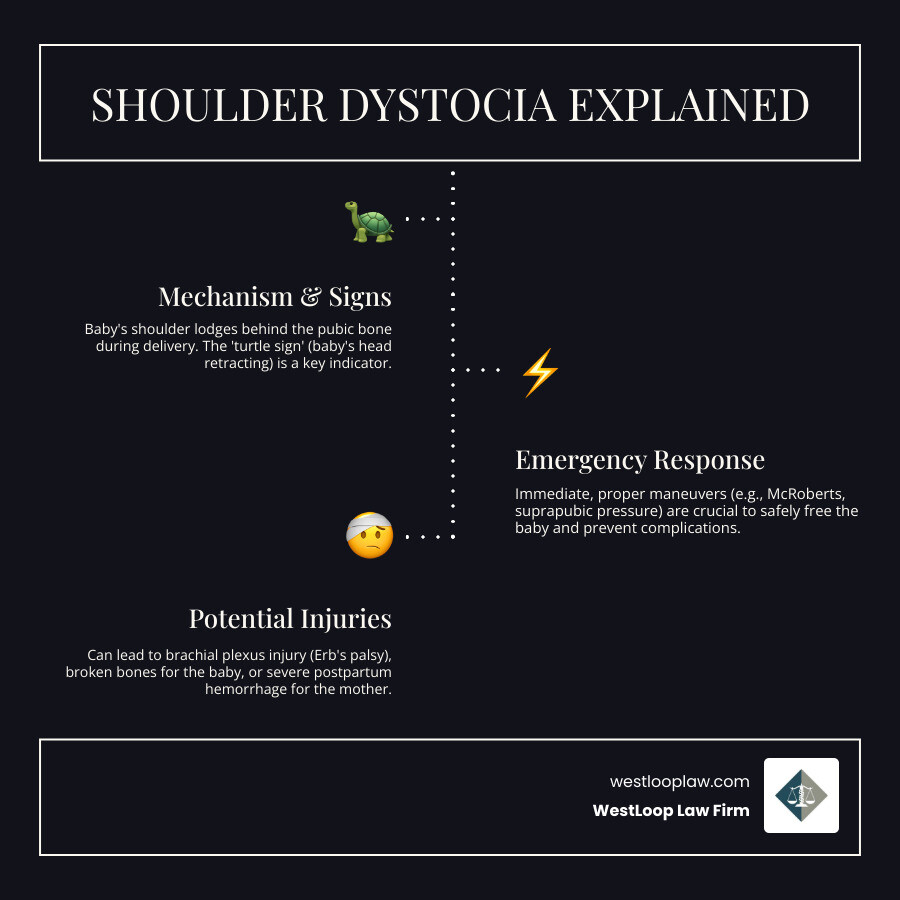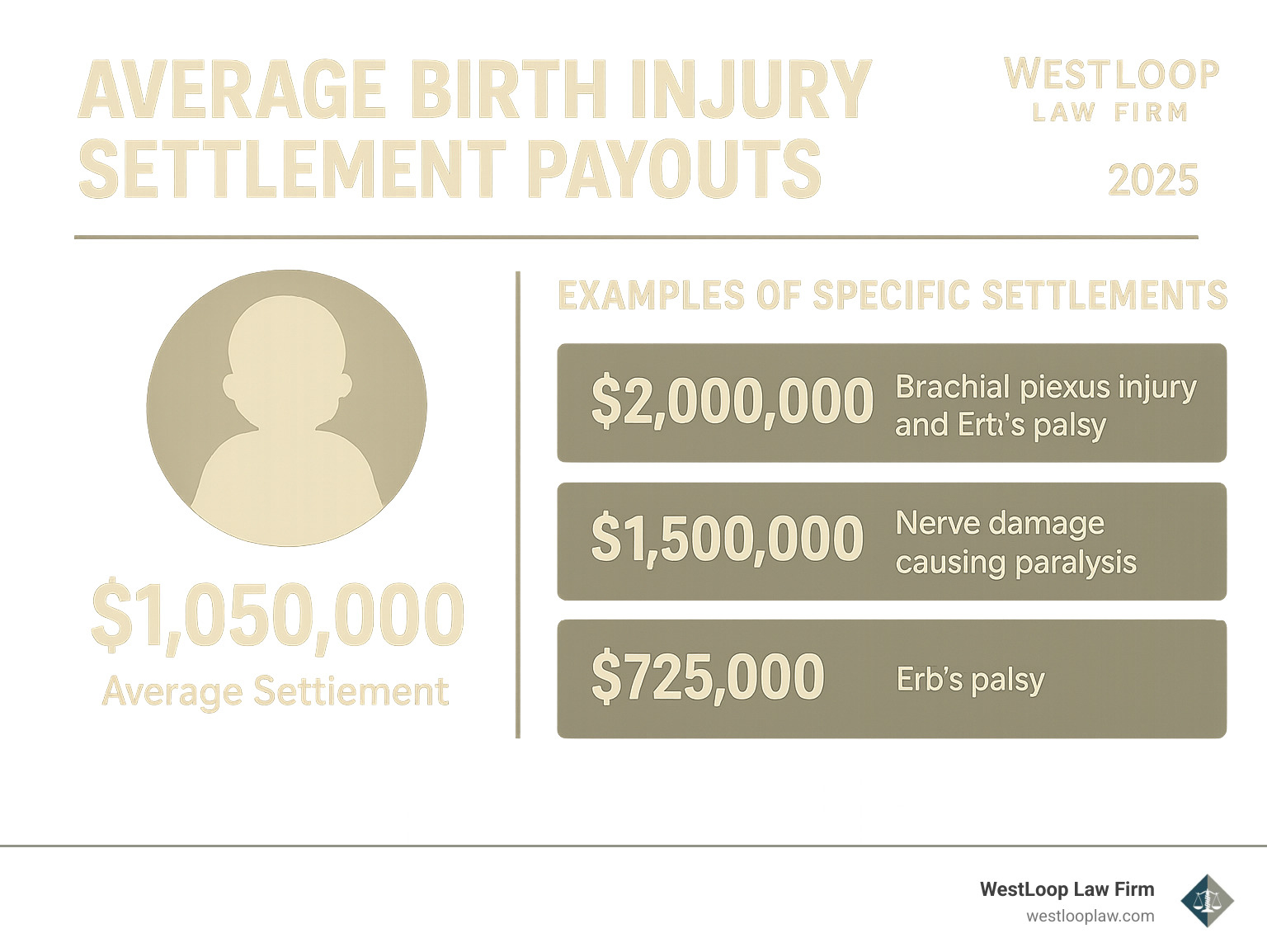Understanding Your Rights When Birth Complications Occur
A shoulder dystocia attorney helps families seek compensation when medical negligence during childbirth causes preventable injuries. These lawyers handle cases where a doctor’s failure to manage this obstetric emergency results in harm to the baby or mother.
Key facts about shoulder dystocia legal claims:
- Occurs in 0.6% to 1.4% of births for babies under 8 lbs 13 oz
- Risk increases to 5-9% for larger babies (over 8 lbs 13 oz)
- Can cause permanent nerve damage, brain injuries, or broken bones
- Medical malpractice may involve excessive force, delayed response, or failure to anticipate risks
- In Texas, families generally have two years to file a lawsuit
- Most attorneys work on a contingency basis
Shoulder dystocia is a medical emergency where a baby’s shoulders get trapped behind the mother’s pelvic bone during delivery. While it can occur with proper care, providers must respond correctly to prevent serious injuries like brachial plexus palsy, which can cause permanent arm weakness or paralysis. For mothers, risks include severe bleeding or uterine rupture.
Not every difficult birth is malpractice. However, if a doctor fails to recognize risk factors, uses excessive force, or deviates from established protocols, families may have a legal claim. The average birth injury settlement is around $1 million, with many cases awarding more to cover lifelong medical care and other costs.
Understanding Shoulder Dystocia: Causes, Risks, and Injuries
Shoulder dystocia is a serious birth complication that can have lasting consequences. Understanding what happened during your delivery is a key step in determining if you need a shoulder dystocia attorney.
What is Shoulder Dystocia?
Shoulder dystocia occurs when, after the baby’s head is delivered, the shoulders become stuck behind the mother’s pelvic bone, preventing the birth. This is an obstetric emergency requiring immediate action. The primary warning is the “turtle sign”, where the baby’s head retracts against the mother’s body.
Statistics show it occurs in about 0.6% to 1.4% of births for average-weight babies, but the risk increases to 5% to 9% for babies over 8 lbs 13 oz. The main danger is umbilical cord compression, which can cut off oxygen and lead to brain damage if the baby is not freed quickly.
Common Risk Factors
Doctors should recognize risk factors and plan accordingly, sometimes recommending a C-section to avoid complications.
- Fetal macrosomia: A baby larger than average (over 8 lbs, 13 oz) is the biggest risk factor.
- Maternal diabetes: This can lead to larger babies with disproportionately large shoulders.
- Previous shoulder dystocia: Increases the risk in subsequent pregnancies.
- Assisted vaginal delivery: Using forceps or vacuum extractors increases the risk significantly.
- Other factors: Maternal obesity, prolonged or very rapid labor, and post-term delivery can also contribute. The March of Dimes provides excellent resources on these risks.
Potential Injuries to the Baby and Mother
Improper management of shoulder dystocia can cause devastating injuries requiring lifelong care.
For babies, the most common injury is brachial plexus palsy, where the network of nerves in the shoulder is stretched or torn. Shoulder dystocia increases this risk over 100-fold.
- Erb’s palsy affects the upper nerves, causing weakness or paralysis in the arm and shoulder.
- Klumpke’s palsy affects lower nerves, impacting hand and wrist function.
- Broken bones, such as the clavicle (collarbone), can occur during maneuvers to free the baby.
- Hypoxic-ischemic encephalopathy (HIE) is a severe brain injury from oxygen deprivation, potentially causing cerebral palsy or developmental delays.
Mothers also face risks, including postpartum hemorrhage (PPH), severe perineal tears, and, in rare cases, a life-threatening uterine rupture.
Medical Standards of Care vs. Medical Malpractice
When shoulder dystocia occurs, medical teams have clear protocols to follow. Understanding the difference between proper care and medical negligence is key to knowing if you need a shoulder dystocia attorney.
Standard Medical Response to Shoulder Dystocia
Medical teams use a systematic approach, often guided by the HELPERR mnemonic, to manage this emergency. These protocols are based on ACOG practice guidelines and represent the standard of care.
- Help: The delivering doctor calls for additional staff, including anesthesiologists and neonatologists.
- McRoberts maneuver: The mother’s legs are pulled toward her chest to open the pelvis. This, combined with suprapubic pressure, resolves about 50% of cases.
- Suprapubic pressure: Firm pressure is applied above the mother’s pubic bone to dislodge the baby’s shoulder.
- Internal maneuvers: If initial steps fail, the doctor may perform the Wood’s corkscrew or Rubin II maneuver to rotate the baby’s shoulders internally.
- Remove the posterior arm: Delivering the baby’s back arm first can reduce their width and free the stuck shoulder.
- Roll the patient: Moving the mother onto her hands and knees can change the pelvic dimensions.
- Zavanelli maneuver: A last-resort measure where the baby’s head is pushed back into the birth canal for an emergency C-section.
Our Medical Mistakes Lawyers are deeply familiar with these protocols, helping us identify deviations from the standard of care.
When Does a Difficult Birth Become Medical Negligence?
Not every injury from shoulder dystocia is due to malpractice. Negligence occurs when the medical team’s actions fall below the accepted standard of care.
- Failure to anticipate risks: Ignoring risk factors like gestational diabetes or a large baby and not planning accordingly (e.g., recommending a C-section).
- Improper use of delivery tools: Using forceps or vacuum extractors incorrectly or without justification.
- Excessive traction on the baby’s head: Pulling too hard on the baby’s head or neck is a common cause of brachial plexus injuries and a clear breach of care standards.
- Delayed response: Failing to recognize the “turtle sign” immediately and begin maneuvers without delay, increasing the risk of oxygen deprivation.
- Failure to perform proper maneuvers: Skipping steps in the HELPERR protocol or performing them incorrectly.
To prove medical negligence, a lawyer must show the provider had a duty of care, breached that duty, and this breach directly caused an injury resulting in damages. Our guide on Medical Malpractice vs Negligence What’s the Difference in Houston TX explains these concepts further.
Pursuing Justice with a Shoulder Dystocia Attorney
When a preventable birth injury occurs, pursuing legal action can secure the resources your child will need for life. A dedicated shoulder dystocia attorney acts as your advocate in this fight.
First Steps for Families After a Birth Injury
In the confusing days after a birth injury, taking these steps can protect your child’s health and a potential legal claim.
- Prioritize medical care: See professionals like neurologists or physical therapists who understand birth injuries. Their records will document the extent of the harm.
- Document everything: Keep a journal of appointments, conversations with medical staff, and all related expenses. Save receipts for travel, parking, and special equipment.
- Avoid quick decisions: Do not sign documents or accept settlement offers from hospitals or insurers without legal advice. A fair settlement must account for your child’s entire future, not just current bills.
- Preserve evidence: Save all photos, notes, and communications from your hospital stay. For help on what to ask, see our guide on Questions Ask Houston Medical Malpractice Lawyer.
How a Shoulder Dystocia Attorney Can Build Your Case
Building a strong medical malpractice case requires a thorough and strategic approach.
- Investigation: We start by listening to your story and then conduct a deep investigation. We request and scrutinize all medical records, from prenatal care to current treatments, looking for deviations from protocol or inconsistencies.
- Detailed analysis: Our team analyzes every chart and timeline to identify errors. We look for signs that the medical team failed to follow proper procedures, used excessive force, or responded inappropriately.
- Professional Testimony: We consult with respected obstetricians, neurologists, and other medical professionals. Their testimony helps explain complex medical issues to a jury and establishes whether the standard of care was met.
- Proving negligence: We connect the dots between a medical mistake and your child’s injury. Our Proving Negligence Investigative Techniques Houston Medical Malpractice Cases help us build this crucial connection.
- Calculating future needs: We work with life care planners and economists to calculate the full lifetime cost of your child’s injury, including therapy, special equipment, and lost earning potential.
- Filing your claim: With a comprehensive case prepared, we handle all legal procedures and fight to get your family the compensation you deserve.
At WestLoop Law Firm, we know that no amount of money can reverse the injury, but it can provide for your child’s quality of life. That’s why we are committed to fighting for their future.
Compensation and Legal Timelines in a Shoulder Dystocia Lawsuit
When pursuing a shoulder dystocia lawsuit, it’s crucial to understand the potential compensation and the strict legal deadlines. These cases are complex, and awards are intended to cover a lifetime of needs for an injured child.
What Compensation Can Be Recovered?
Compensation in a successful shoulder dystocia attorney lawsuit helps families manage the immense costs of a birth injury. It covers both tangible and intangible losses.
Economic damages are the direct financial costs, including:
- Past and future medical expenses: Surgeries, hospital stays, medication, and ongoing physical, occupational, and speech therapy.
- Lifelong care costs: In-home attendant care, home modifications (ramps, accessible bathrooms), and specialized equipment.
- Lost earning capacity: Compensation for the income your child will be unable to earn as an adult due to their injury.
Non-economic damages address the profound, non-financial losses, such as your child’s pain and suffering and the emotional distress your family endures.
While the average birth injury payout is around $1 million, many settlements result in multimillion-dollar awards. This reflects the true lifetime cost of caring for a child with a severe, preventable injury. For more details, see our Lawyer for Medical Malpractice Compensation Guide.
Understanding the Statute of Limitations in Texas
You can lose your right to compensation by waiting too long to file a lawsuit. This legal deadline is called the statute of limitations.
In Texas, you generally have two years to file a medical malpractice claim, usually measured from the date of the alleged negligence or injury. Limited exceptions may apply in certain cases involving birth injuries or minors, but do not assume extra time applies.
Because of these strict and complex deadlines, acting quickly is vital. Contacting an experienced shoulder dystocia attorney as soon as possible protects your legal rights. At WestLoop Law Firm, we can help you steer these time-sensitive issues. Learn more on our Texas Medical Malpractice Lawyer page.
Frequently Asked Questions About Shoulder Dystocia Claims
Families facing a birth injury often have many questions. Here are clear, honest answers to some of the most common concerns we hear at WestLoop Law Firm.
Is shoulder dystocia always considered medical negligence?
No, the occurrence of shoulder dystocia itself is not automatically medical negligence. It is a known obstetric complication that can happen even with excellent care.
Negligence arises from how the medical team responds. It can involve:
- Failure to anticipate risks: Ignoring clear warning signs like a large baby or maternal diabetes and not preparing for a difficult delivery.
- Improper response: Panicking, delaying treatment, or failing to follow established protocols like the HELPERR maneuvers.
- Excessive force: Pulling too hard on the baby’s head or neck when the shoulders are stuck. This is a clear breach of the standard of care and a leading cause of permanent nerve damage.
The key is whether the healthcare provider’s actions fell below the standard of care that a reasonable peer would have provided.
How much does it cost to hire a shoulder dystocia attorney?
At WestLoop Law Firm, we work on a contingency fee basis. This means:
- No upfront costs: You pay nothing to hire us or to start your case.
- Payment only if you win: We receive our fee as a percentage of the compensation we recover for you. If we don’t win your case, you owe us nothing for our legal services.
This approach ensures everyone has access to justice, regardless of their financial situation. We offer risk-free consultations to discuss your case without any cost or obligation.
What is the most common injury associated with shoulder dystocia?
The most common and life-altering injury is brachial plexus injury (BPI). The brachial plexus is the network of nerves running from the neck to the arm that controls movement and sensation.
During a difficult shoulder dystocia delivery, these nerves can be stretched, compressed, or torn. Shoulder dystocia increases BPI risk significantly—by more than 100 times.
- Erb’s palsy is the most frequent type of BPI, affecting the upper nerves and causing weakness in the shoulder and arm.
- Klumpke’s palsy is less common and affects the lower nerves, impacting hand and wrist function.
Many of these nerve damage cases are preventable with proper medical management, which is why legal recourse is so important for affected families.
Conclusion: Securing Your Family’s Future
The birth of a child should be a joyous occasion. When shoulder dystocia leads to a preventable injury, that joy can be overshadowed by a difficult and uncertain future. However, understanding your legal rights provides a path forward.
We’ve explained that shoulder dystocia is a medical emergency, but injuries like brachial plexus palsy or brain damage often result from medical negligence—such as failing to recognize risks like fetal macrosomia, responding too slowly, or using excessive force.
These injuries can require a lifetime of care, therapy, and support. A dedicated shoulder dystocia attorney fights to secure the financial resources your child will need to live their life to the fullest. At WestLoop Law Firm, we understand that while no amount of money can undo the harm, compensation can provide for your child’s future needs.
Our firm’s combined experience in personal injury and probate law allows us to build compelling cases for our clients. We work on a contingency fee basis, so you pay no attorney fees unless we win your case.
The statute of limitations in Texas is strict, making it critical to act quickly to preserve your right to seek justice. Pursuing a claim is about more than accountability; it’s about securing the resources your child needs to thrive.
If your family has been affected by a birth injury from shoulder dystocia, you are not alone. We are here to listen and help you understand your legal options.
Contact our Houston Medical Malpractice Lawyers for a free consultation today. Let us help you take the first step toward securing the justice and compensation your family deserves.





